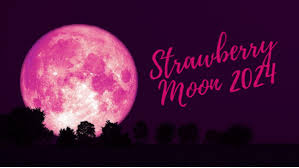Strawberry Moon is going to be visible in the sky on the full moon day on June 21. On this day, the color of the moon will be light yellow and light red, which will look a bit like a strawberry. The moonlight will also be very bright on this day. This view can be seen from June 20 to June 22. This month, on June 21, the night is going to look like day. There is a full moon on 21st June and on this day the moon will be in its full glory. Its milky light will be so bright that you will feel as if it is day. This phenomenon is called the Strawberry Moon. However, this bright light of the Moon will start becoming visible from June 20 itself and will also be visible on June 22. The moon will appear bright and full on these three days i.e. Thursday, Friday and Saturday.
The proximity of the full moon to the date of the solstice or the beginning of astronomical summer has a notable visual effect. Since the full moon is opposite the Sun relative to Earth, it reflects the Sun’s position in the sky. In June—and especially near the solstice—the Sun is at its highest point of the year in the Northern Hemisphere. This year, its position is highest till now at noon on Sankranti on 20th June. This makes the full moon the next day the lowest point of the year. When is the Strawberry Moon
It is also the farthest full moon from the Sun of the year. This is because Earth’s slightly elliptical orbit around the Sun takes it farthest on July 5. That point is Earth’s annual aphelion. Therefore, the full moon closest to that date must be the Moon’s annual aphelion. How the Strawberry Moon Got Named
According to timeanddate.com, the Strawberry Moon was named by American astronomers. Its name is derived from the wild strawberries that ripen in this month. Other Native American names for the June full moon include the Berries Ripe Moon, Green Corn Moon, and Hot Moon. According to the Center for Native American Studies, the Anishinaabeg or Ojibwe, the indigenous people of the Great Lakes region, know it as Wabigoni Gijis (Blooming Moon).




